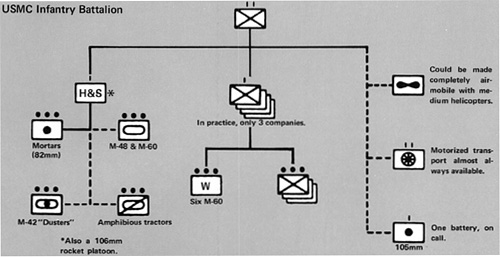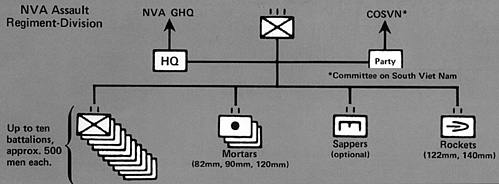USMC Rifle Battalion
Basically the USMC Rifle Battalion is simply a heavy battalion with four infantry companies. what made it so effective was all the extra support units it could have attached with little or no change in its structure. In a nutshell it was a "maneuver module" that could be easily and quickly tailored to fit the mission. The organic weapons platoon is also particularly potent with a total of six M-60 machineguns. With all its potential "benefit" units attached, it resembled not a rifle battalion, but a "mechanized weapons battalion" with infantry support. All in all, the Marine Infantry Battalion was probably the most versatile military unit deployed, by either side, in the Vietnam War.

NVA Assault Regiment (Division)
For the Tet Offensive of 1968 the NVA created a special unit. Nominally it was a regiment, however, it packed the firepower of a division. In many ways it was like the taskforces which were being used by the USMC forces in I Corps. It was very flexible and could be tailored both on the basis of need, and on what was actually available. A unique feature was the duality of command. Both the nominal military headquarters and the attached party committee reported to a "higher" authonty. In 1968 the influence of the party committee was actually somewhat stronger than the convennonal military headquarters. This was why most of the city attacks were centered against political objectives, and why a number of the attacking forces made relevant military blunders. However, considering the nature of revolutionary war, it is still perhaps a desirable trait.

ARVN Heavy Infantry Division
The Heavy Division gets its name from the fact that it has 12 maneuver battalions, grouped into three regiments. Most conventional regiments have three battalions. The idea to increase the strength of the ARVN regiments to four battalions was first started in 1966, the theory being that the extra battalion would give the ARVN an edge when fighting the NVA/VC three-battalion regiment However, due to manpower, training, and leadership limitations this program had to be carried out gradually and extended into 1968. The main reason for the delay was that in 1966 most of the ARVN infantry battalions were understrength, with often no more than 300 men per battalion. So the first step was to get the exisang battalions up to strength, and then make the expansion to the 12-battalion division. By 1968 the better units of the Army of the Republic of VietNam {the First and Second Infantry Divisions) had been raised to this configuration, and also had their transport units enlarged so as to give them much greater road mobility.
How effective has the change been? In the case of the First Division it has been very effecave. Sometimes the extra battalion is used as a training battalion. This enables the regiments to have three battalions in combat operations and also have an organic training unit so that new recruits and draftees are not forced to learn as they go as in a "hot" unit. Its effectiveness was brought out in the 1972 "Year of the Rat" offensive, when the NVA sent one of their best divisions, the 324B, to attack Hue. Though the First was caught unsuspecting it still managed to intercept the NVA 324B and sent it retreating back into the Ashau Valley.

More Tet Offensive
-
Tet Offensive: Introduction
Tet Offensive: US and North Vietamese Strategy
Tet Offensive: Battle for Hue
Tet Offensive: Soldiers
Tet Offensive: Tactical Organization and Equipment
Tet Offensive: Maps: Battle for Hue (very slow: 329K)
Back to Campaign Number 93 Table of Contents
Back to Campaign List of Issues
Back to MagWeb Master Magazine List
© Copyright 1979 by Don Lowry
This article appears in MagWeb (Magazine Web) on the Internet World Wide Web.
Other military history articles and gaming articles are available at http://www.magweb.com